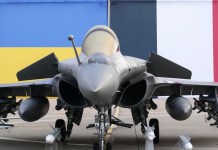The US military’s Indo-Pacific Command has a sought a fund of $27.4 billion to build a network of precision-strike missiles to counter China’s aggressive posture in the region.
The plan envisages developing and deploying these missiles along the first island chain on the west of the International Date Line (IDL) over the next six years. IDL is an imaginary line of demarcation on the Earth’s surface running from the North Pole to the South Pole.
Within the first island chain, Beijing aims to push American forces out of the East and South China seas as part of its “anti-access/area denial” strategy. The first chain of islands is a group of island territories including Taiwan, Okinawa, and the Philippines, which China sees as its first line of defense.
The US Indo-Pacific Command has submitted the core proposal titled ‘Pacific Deterrence Initiative’ (PDI) to Congress. It is an investment plan for fiscal 2022 through fiscal 2027. China had been hoping that Washington’s stance towards Beijing would soften under Joe Biden but that may not be the case with the US’s Indo-Pacific Command coming up with such elaborate plans for the region.
Adm. Philip Davidson, commander of the Indo-Pacific Command, has raised concern that the next six years can be a period when China may look to change the status quo in the region, such as with Taiwan.
Underlining that China’s attempts to change the status quo could be permanent, he said there is “a fundamental understanding that the period between now and 2026, this decade, is the time horizon in which China is positioned to achieve overmatch in its capability, and when Beijing could, ‘could,’ widely choose to forcibly change the status quo in the region”.
#USSTheodoreRoosevelt Carrier Strike Group conducts second bilateral exercise with Japan Maritime Self-Defense Force during @US7thFleet deployment: https://t.co/nGAZmximEm #NavyPartnerships #FreeAndOpenIndoPacific pic.twitter.com/qBcxJukxIh
— U.S. Pacific Fleet (@USPacificFleet) March 3, 2021
The document submitted to Congress read: “Without a valid and convincing conventional deterrent, China is emboldened to take action in the region and globally to supplant U.S. interests. As the Indo-Pacific’s military balance becomes more unfavorable, the U.S. accumulates additional risk that may embolden adversaries to unilaterally attempt to change the status quo.”
In addition to precision-strike missile networks, the document suggests placing integrated air defense, and a distributed force posture that provides the ability to preserve stability, and if needed, dispense and sustain combat operations for extended periods in the second island chain.
China aims to thwart American attempts to reach the second island chain in the Western Pacific from southeastern Japan to Guam and south to Indonesia. The document states that plan is to focus resources on vital military capabilities to deter China. Previously, China has objected to the US’ attempts to place missile shields in allied countries in the Indo-Pacific.
The US has long strengthened its naval and air forces in Indo-Pacific with an aim to deter China and the current plan includes “highly survivable, precision-strike networks along the first island chain” as a central element.
The US Indo-Pacific Command has requested $4.7 billion for fiscal 2022, almost double the $2.2 billion earmarked for the region in fiscal 2021. The amount is almost equal to what Washington has spent annually on dealing with Russia. The $27.4 billion represents a 36% increase over planned spending for that period as of fiscal 2020.
Follow EurAsian Times on Google




